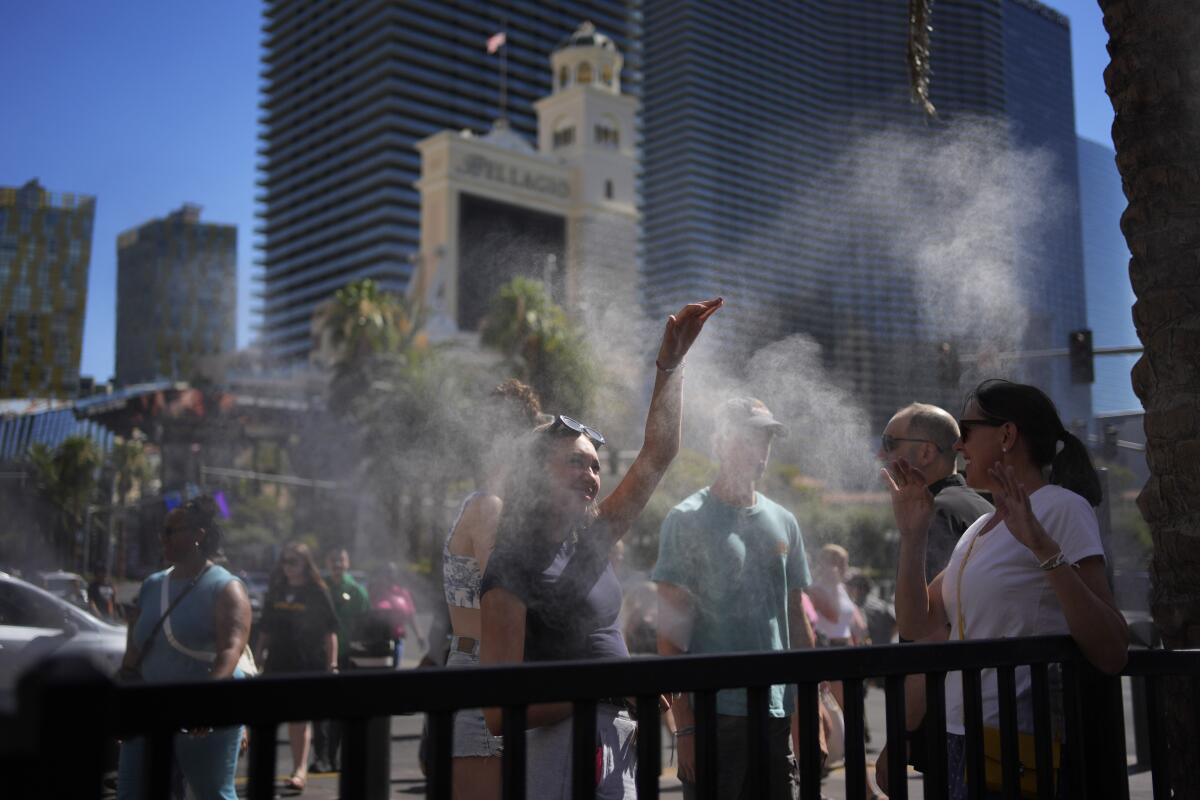‘Unprecedented’ heat wave in California brings death, fires, all-time highs

- Share via
The intense, early-season heat wave broiling much of the Western U.S. has already set many records and contributed to several deaths, yet it’s far from over: The heat is forecast to continue for another week, bringing triple-digit temperatures and compounding health and wildfire concerns across California and surrounding states.
“It’s unprecedented heat — take this very seriously,” said Dan Berc, a National Weather Service meteorologist in Las Vegas. “It’s not normal, this is excessive heat. ... We’re talking 10 to 12 degrees above normal for the hottest part of the year.”
Several fatalities across the West have been linked to the severe heat. A motorcyclist died Saturday in Death Valley National Park after several members of the cyclist’s group became distressed by the heat. In the Portland, Ore., area, officials reported four suspected heat-related deaths that occurred Friday to Sunday. And in Grand Canyon National Park, as temperatures rose into the mid-90s, a hiker was found dead Sunday, according to the National Park Service, though the cause of death wasn’t immediately clear.
The California Coalition for Women Prisoners, which monitors conditions inside prisons, reported Monday that an inmate at the Central California Women’s Facility in Chowchilla died of heatstroke after temperatures at the facility soared. The California Department of Corrections and Rehabilitation, however, said the woman’s cause of death appeared to be from an ongoing medical condition, not heat-related. The official cause of death is still under investigation and will be determined by the local coroner’s office.
Extreme heat has become the nation’s deadliest weather-related hazard, according to the National Weather Service, which has continued to beef up its warning systems to encourage people, especially vulnerable populations, to take precautions.
The high temperatures were was also blamed for a massive fish die-off in Lake Elizabeth in Northern California, according to Fremont city officials.
Las Vegas on Sunday smashed its record high temperature by three degrees, hitting 120 for the first time since record-keeping began in 1937, according to the weather service. Several record highs were set this weekend across California, including in the eastern deserts, Antelope Valley and the state’s northwest corner.
Officials say the temperatures are eye-popping on their own, but the number of days topping 100, 110 or 115 degrees is also remarkable — and dangerous.
Much of inland California is expected to remain under an excessive heat warning through at least Friday, with many areas facing extreme heat risk several days in a row, forecasts show.
The San Joaquin Valley is expected to be under an excessive heat alert for 12 days straight — from early last week until Saturday — with weather officials warning that “this level of rare, long-duration extreme heat, with little to no overnight relief, affects everyone.”
While the Central Valley is accustomed to hot summers, health risks increase when overnight temperatures remain high. Some areas, including Bakersfield and Fresno, did not fall below 80 degrees Sunday.
“That could be potentially one of the longest [excessive heat warnings], if not the longest,” said Andy Bollenbacher, a National Weather Service meteorologist in Hanford. “This ridge of high pressure — it’s very strong, and it’s not moving anywhere.”
That high-pressure ridge — often referred to as a heat dome — is parked over the West, and nothing is expected to interfere with it for days, until it begins to move slightly eastward.
“We have a very large and long-standing pressure cooker over the San Joaquin Valley, and really all of California, keeping us very hot for a very long time,” Bollenbacher said.
It’s difficult to tie one heat wave directly to climate change, but researchers continue to find that human-caused global warming drives more frequent and more intense heat events. Recent heat waves are more likely to break records amid warmer worldwide temperatures as well as increased urbanization, which raises baseline temperatures, Berc said.
A powerful high-pressure ridge will bring unusually hot temperatures to the Golden State by the middle of this week, before spreading into the Pacific Northwest.
“We’ve had long-duration heat waves, but to have this combined with the magnitude of the heat … is unprecedented,” said Mike Wofford, a meteorologist for the National Weather Service in Oxnard.
UCLA climate scientist Daniel Swain said in a weekend briefing that this weather is part of a larger trend of warmer temperatures over time.
“There are people in California who have experienced not only the hottest day that they’ve ever experienced but also the hottest day that their parents or grandparents ever would have experienced,” Swain said.
In Southern California, Palmdale and Lancaster on Sunday set records for the most consecutive days at or above 110 degrees — four — according to the National Weather Service, which has collected this data since the 1930s and 1940s. Wofford said that streak of consecutive days over 110 degrees is expected to continue this week.
Highs are “all over 110 until maybe Friday,” Wofford said. Lancaster also tied its all-time record high, at 115 degrees Sunday.
Las Vegas is also expected to break all-time records for consecutive days at or above 110 degrees, Berc said. Sin City had seen four days in a row over 110 as of Sunday night and is forecast to remain just as hot through early next week.
“We’re looking at maybe 15 days in a row,” Berc said. “That’s a record I expect we’re going to destroy.”
In the Mojave Desert, record highs were tied Sunday, with Barstow hitting 118 and Bishop reaching 111, according to the National Weather Service. Barstow-Daggett Airport set a daily record minimum temperature for July 5, never dropping below 85 degrees.
Selling off oil and gas investments from state pension funds likely won’t cut carbon emissions, but it will cost California retirees.
Highs in areas of northwest California also set historic records Saturday, according to the National Weather Service’s Eureka office. Covelo hit 117, beating its prior all-time high of 115; Alderpoint made it to 113 passing the prior record of 112; and Hoopa hit 114, surpassing the prior 111.
The rest of this week will continue to be hot across much of California, with highs 10 to 15 degrees above average for early July, Wofford said.
California’s most eastern deserts are forecast to see the worst conditions through Thursday, with the weather service’s Las Vegas office warning of “dangerously hot conditions for an unusually long period.” Highs across Owens Valley to Death Valley are expected to span from 105 to 129 through Thursday, the warning said.
The Sacramento Valley will remain under the excessive heat warning through Friday night, with hopes that next weekend could see temperatures finally dip below 100.
Most of southwestern California, besides the coast, will remain under heat advisories through at least Thursday, with the weather service urging residents to “take action when you see symptoms of heat exhaustion and heat stroke.”
“Anyone overcome by heat should be moved to a cool and shaded location,” the weather service said. “Heat stroke is an emergency!”

Much of Northern California — Trinity, Mendocino, Humbolt and Lake counities — remained under an excessive heat warning through Monday evening.
Temperatures in the Pacific Northwest were also expected to remain well above average, with an excessive heat warning in effect across much of Oregon and Washington, where record highs this weekend reached the 90s and low 100s.
The National Weather Service is warning that this heat wave will continue to bring “elevated to critical fire weather conditions” across the interior, stoking “large fire growth” for new or existing blazes.
The latest fast-growing fire, in the Los Padres National Forest in Santa Barbara County, had surged past 20,000 acres as of Monday. The Lake fire has forced evacuations and was listed as 8% contained Monday morning.
Staff writer Nathan Solis contributed to this report.
More to Read
Sign up for Essential California
The most important California stories and recommendations in your inbox every morning.
You may occasionally receive promotional content from the Los Angeles Times.














